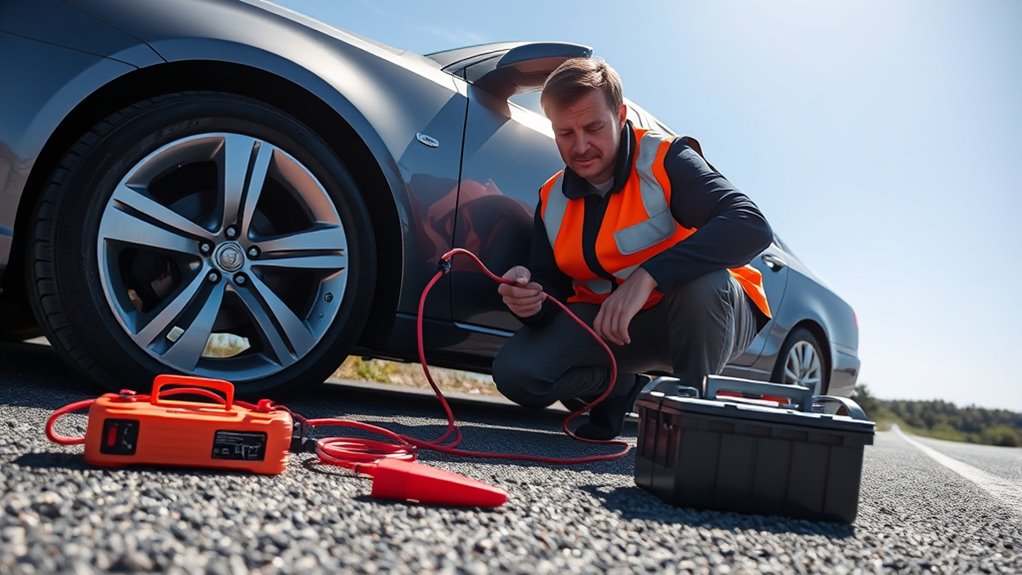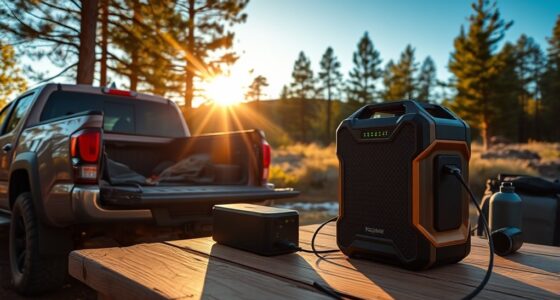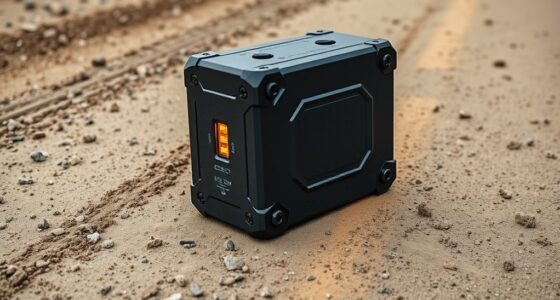To jump-start your car and power your gear, you need a well-stocked emergency kit and basic knowledge of safety procedures. Turn on hazard lights, connect jumper cables correctly—red to red, black to black—and start the working vehicle first. Wait a few minutes for the dead battery to charge, then try restarting yours. Knowing these steps and having the right gear can save your day; keep going to discover more tips that keep you prepared.
Key Takeaways
- Prepare your emergency kit with jumper cables, flashlight, and safety items before roadside issues occur.
- Ensure both vehicles are turned off, then connect jumper cables red to red, black to black, avoiding sparks.
- Start the donor vehicle first, wait a few minutes, then attempt to start the disabled vehicle.
- Check for signs of battery weakness, like dim lights or slow engine turnover, and replace the battery if needed.
- Regularly inspect and maintain your battery to prevent breakdowns and ensure quick, safe jump-starts when necessary.

When your car suddenly breaks down on the side of the road, a roadside rescuer becomes your immediate lifeline. In these moments, knowing how to jump-start your vehicle and manage your emergency gear can make all the difference. One of the most common causes of breakdowns is a dead battery, which makes battery maintenance essential. Regularly inspecting your battery, ensuring the terminals are clean, and checking for corrosion can prevent unexpected failures. However, even with good maintenance, batteries can unexpectedly die, especially in extreme weather conditions. That’s where your emergency kit comes into play. A well-stocked kit, including jumper cables, can help you get back on the road quickly without waiting for roadside assistance.
When you’re stranded, safety should be your top priority. First, turn on your hazard lights and position your vehicle away from traffic if possible. Once you’re safe, retrieve your emergency kit and locate the jumper cables. Connecting the cables correctly is critical—red to red, black to black—so you don’t cause any electrical issues or sparks. If you’re unsure about the process, many vehicles provide step-by-step instructions, or you can consult your owner’s manual. With a helper, you can then start the functioning vehicle and let it run for a few minutes to transfer charge. Afterward, attempt to start your car. If it cranks but doesn’t start, wait a few moments and try again. If it still doesn’t turn over, your battery may need replacement, or there could be a more serious electrical problem.
In addition to jump-starting, your emergency kit should contain items to keep you comfortable and safe if repairs take longer or if you need to wait for roadside assistance. Flashlights, reflective triangles, and warm clothing can help you stay visible and protected. Remember, proper battery maintenance extends beyond jump-start procedures; regularly checking your battery’s health can prevent emergencies altogether. If your battery shows signs of weakness—dim headlights, slow engine turnover—consider replacing it before it leaves you stranded. Utilizing battery maintenance techniques can help prolong your battery’s lifespan and reliability.
Being prepared with a good understanding of battery maintenance and an organized emergency kit empowers you to handle roadside emergencies confidently. When your car refuses to start, and you’re left stranded, these simple but essential steps can save you time, money, and stress. With the right tools and knowledge, you’re well-equipped to jump-start your car safely and keep your gear powered until professional help arrives. Staying proactive about your vehicle’s health and keeping your emergency kit stocked ensures you’re ready for any roadside surprise.
Frequently Asked Questions
Can I Use a Roadside Rescuer on Motorcycles?
You might wonder if a roadside rescuer is suitable for motorcycles. Generally, portable jump starters designed for cars aren’t ideal due to motorcycle compatibility issues. Many jump starters lack the necessary voltage or connectors for motorcycles, risking damage or ineffective boosting. Always check your device’s specifications and instructions, guaranteeing it’s compatible with motorcycles before use. Using the right portable jump starter prevents damage and ensures reliable assistance when you need it most.
What Safety Precautions Should I Follow During Jump-Starts?
Think of jump-starting as steering a stormy sea—you need to stay safe and alert. Always prioritize battery safety by wearing gloves and eye protection. Keep the jumper cables in good condition, and avoid touching their clamps together to prevent electrical hazards. Confirm the vehicles are off before connecting, and follow the correct order when attaching cables. Staying cautious helps you avoid sparks, shocks, and other dangers during the process.
How Do I Store My Roadside Rescuer for Longevity?
To guarantee your roadside rescuer stays functional over time, focus on proper storage and battery maintenance. Store it in a cool, dry place away from direct sunlight and extreme temperatures. Regularly check the battery’s charge level and recharge it as needed to prevent capacity loss. Keep the device clean and dry, and follow the manufacturer’s instructions for long-term storage. Proper storage helps extend its lifespan and ensures it’s ready when you need it most.
Will Using a Roadside Rescuer Harm My Car’S Electronics?
Using a roadside rescuer generally won’t harm your car’s electronics if you verify battery compatibility. Modern jump starters are designed to prevent electronic interference, protecting sensitive components. Always double-check that the device matches your car’s voltage and battery type. When used correctly, these tools safely jump-start your car without risking damage to your vehicle’s electronic systems. Proper usage and compatibility are key to avoiding any electronic issues.
Is a Roadside Rescuer Effective in Extreme Weather Conditions?
You might wonder if a roadside rescuer works well in extreme weather. The truth is, its rescue effectiveness can vary. In cold conditions, it can help jump-start your car if the battery dies, but freezing temperatures may weaken batteries and reduce overall effectiveness. In extreme heat, electronics might overheat, affecting performance. Always guarantee your device is rated for harsh conditions and follow safety instructions for ideal rescue results.
Conclusion
Now that you’re armed with the knowledge to jump-start your car and power your gear, you’re like a modern-day knight ready to face any roadside challenge. With a flick of your wrist and a quick connection, you turn a potential disaster into a minor hiccup. Think of yourself as the hero who keeps the journey alive, steering through unexpected storms with confidence. The road may twist and turn, but you’ve got the power to keep moving forward.









